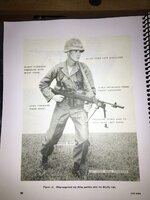Platinum Supporter
Gold Lifetime
Bronze Lifetime
- Messages
- 3,304
- Reactions
- 3,530
The intent of 5.56 was for something more controllable in full auto. They replaced the M14 due to how difficult full auto was to handle with it.
Keeping in mind that light machine guns like the M249 aren't the only guns used for suppressive fire, a lot of rounds are used just to keep enemy heads down.
As a person who trained and qualified with a full automatic M-14, I'll call that a misinformation. The M14A1 (Sometimes known as E-1 or E-2 but when it was made a issued weapon it was A-1) The M-14A1 Appeared longer than a regular M-14, but it was still a 22" barrel with a long muzzle brake. It had a bipod and a scary wooden pistol grip, part of the big wood stock. On the forend of the stock was a hinged piece of Bakelite. The sling fastened to the gas assembly and the Bakelite's swivel/hinge. The Bakelite could act as a vertical foregrip that worked with the sling to pull down on the barrel while the rest of the sling was intertwined with the shooters arm providing additional downforce. In the prone, the shooter had his heels together, the imaginary bore axis would split his body right down the split of his posterior and both heels, body and gun in linear. There was no BS mechanical burst control of the trigger, you did it all with your trigger finger. With full auto selected I could send the standard burst of three or a single round, just let you finger do the talking. We used open sights on targets 700 meters away, they were bigger panels, but still hard to see. We also fired our bursts of three from the shoulder standing. Walking fire could be done with the stock tucked up under arm, the arm holding on tight.....Assault fire. Assault fire was not the preferred method.
The M-14A-1 was a replacement for the BAR, it was lighter and hit nearly as hard.
The Army was in a hurry to get replacements for the BAR, but slow to field the M-14A1 so many M-14's were used with a select fire switch. This was a double poor idea, first a compromised weapon and second no real shooter training. The 7.62 full auto M-14 would be no harder to control than a 30 caliber full auto M1 Garand. Doable with training. Lots of extended barrel burning bursts, heavy use of tracers. Amateur stuff.
The Army continued with it's dumb bunny ways with the arrival of the M-16. They gave everyone a select fire weapon and then said only a couple could use them full auto. As soon as the guy next to you fired in auto, everyone went auto. Ammo, Ammo, Ammo!
I carried 19, 18 round magazines, one in gun and the rest in three bandoliers, I carried six frag and four smoke grenades. Six to eight canteens of water. Lots more crap. Lot of work hauling that around.
In any case I think 7.62 full auto is very doable.














